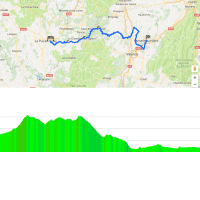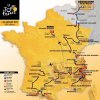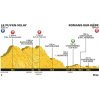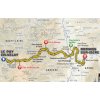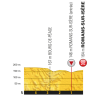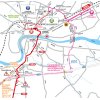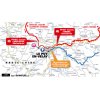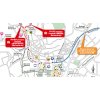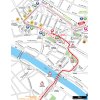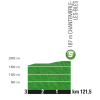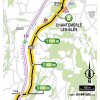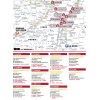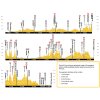Le Puy-en-Velay is a stop on the pilgrimage to Santiago de Compostela, so with a little luck the riders are ‘reborn’ after the rest day. They head for Romans-sur-Isère, which lies in the valley of the River Rhône.
Once the flag is dropped the roads start to go up until Côte de Boussoulet is crested after 20 kilometres. The official climb (3rd category) is 4.5 kilometres at 6.3%. The rolls on and at kilometre 65 the riders are atop Col du Rouvey, which is the highest point of the day at an elevation of 1,250 metres. The climb itself is modest – 2.8 kilometres at 5,6% – before a long drop runs to a gently rolling last section of some 50 kilometres.
One could think of different scenarios. With enough power on board the break away could hold until the end. That said, stages with an arrival in the Rhône valley usually come down to a bunch sprint. In the 4th stage of last year’s Paris-Nice, Nacer Bouhanni outpowered Edward Theuns, André Greipel, Alexander Kristoff and Michael Matthews on the line.
Echelons are another possible scenario. In recent years stages that were marked by crosswinds were bound to bring spectacle. Think the World Championships in Qatar, or the 11th stage in the 2016 Tour de France, when Peter Sagan and Chris Froome took control in a legendary stage.
AG2R’s Pierre Latour was born is arrival place Romans-sur-Isère.
The first three riders on the line take time bonuses of 10, 6 and 4 seconds.
Read also: results/race report 16th stage 2017 Tour de France.
Tour de France 2017 stage 16: Route maps, height profiles, and more
Click on the images to zoom
+ Click for more images (16)
Related articles Riders - Tour de France 2017 Withdrawals - Tour de France 2017 Route and stages - Tour de France 2017 stage 20: Start times ITT - Tour de France 2017 stage 1: Start times ITT - Tour de France 2017 GC Favourites - Tour de France 2017 More articles Giro 2025: Van Uden powers to glory, Pedersen still in pink
Giro 2025 Route stage 4: Alberobello – Lecce
Giro 2025 Route stage 5: Ceglie Messapica - Matera
Giro 2025 Favourites stage 5: For fast men #2
Giro 2025: Withdrawals
Giro 2025: The Route
Giro 2025: Riders
Giro 2025: GC Favourites
Giro 2025 Route stage 6: Potenza - Naples
Giro 2025 Favourites stage 6: Hilly race with flat finale
Giro 2025 Route stage 7: Castel di Sangro - Tagliacozzo
Giro 2025 Favourites stage 7: First mountain top finish
Giro 2025 Route stage 8: Giulianova – Castelraimondo
Giro 2025 Favourites stage 8: Attackers in the Apennines
Giro 2025 Route stage 9: Gubbio - Siena
Giro 2025 Favourites stage 9: Strade Bianche alla Giro
Giro 2025 Route stage 10: Lucca – Pisa
Giro 2025 Favourites stage 10: For pure time trialists
Giro 2025 Route stage 11: Viareggio – Castelnovo ne’ Mont
Giro 2025 Favourites stage 11: Attackers in promising finale
Giro 2025 Route stage 12: Modena – Viadana
Giro 2025 Favourites stage 12: For fast men #3
Giro 2025 Route stage 13: Rovigo - Monte Berico
Giro 2025 Favourites stage 13: Puncheurs at Monte Berico
Cycling Calendar 2025
Tour de France 2025: The Route
Tour de France 2025 Route stage 1: Lille - Lille
Tour de France 2025 Route stage 2: Lauwin-Planque - Boulogne-sur-Mer
Tour de France 2025 Route stage 3: Valenciennes - Dunkirk
Vuelta Femenina 2025 Route stage 6: Becerril de Campos - Baltanás
